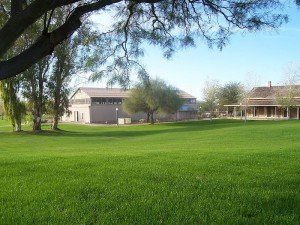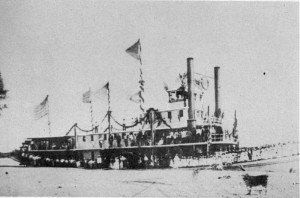An American River Like No Other

The Colorado is a river that exists in a part of the American Southwest where one would think there would be no river. The Colorado River didn’t flow past mighty settlements like St. Louis, Cincinnati, Memphis and New Orleans. After all, this was the Sonora Desert. The Colorado River passed through hot sands and barren wilderness where next to nothing grew. Vegetation was spares to say the least and even the Native Americans who lived near it had a difficult time to even survive. This was a water stream that penetrated a land where there wasn’t water and for someone to think for a moment that this river, the Colorado and Fort Yuma, would someday be an aorta of commerce was totally laughable at best. the river would carry 500,000 tons of silt and sediment per day, in an average day, through the Grand Canyon.
The Colorado River flow was unlike the large rivers of the midwest. The lower Colorado bisects two large deserts in the southwest, the Sonora Desert on the Arizona side and the Mojave Desert on the California side. To the south of the Mojave Desert was the Salton Basin which was a large depression 235 feet below sea level. This large depression would eventually fill up years later, in 1905, when a levee broke on the lower Colorado, after some tinkering by people trying to divert water to the Los Angeles area. What resulted is today’s Salton Sea which many people now see while flying to Los Angeles or San Diego. Yes, the Salton Sea happened by accident. The Salton Basin is about 70 feet deep, 50 miles long, and 15 miles wide, with a total water area of some 300 square miles.
The Colorado River Was Quite Different
The nature of the water that flowed down the Colorado River was different from any other river in North America.

The water was extremely silty, especially on the lower Colorado near Fort Yuma. To give you an idea of the nature of the water, prior to the modern day Glen Canyon Dam constructed at Page Arizona, the Colorado River would carry about 500,000 tons of silt and sediment per day, in an average day, through the Grand Canyon. This is what the people of the 1850’s saw when they reached the Colorado. It wasn’t like the Mississippi, the Missouri, the mighty Columbia or the Ohio Rivers. Yet, regardless of the river’s character and the fact that nobody ever thought the lower Colorado would be a busy transportation highway, it became just that.
You’ll also be interested in our articles on the Steamboat Natchez and High Piracy on the Ohio and Mississippi Rivers.
It Was the Right River at the Right Time
The importance of the Colorado River in the 1850’s could not be overstated for those who traversed this arid region of America. Remember, the 1850’s were the early years of American settlement in the Southwest. The end of the Mexican American War gave title to the lands of the southwest to the United States Government. The trails to the southwest out of Missouri and Texas would bring more people than ever through this passageway across the Sonora Desert to California which was also ceded to the U.S. in 1848. Add to that the U.S. Army’s general incursion into the southwest after 1848 and the Colorado River and the future Fort Yuma suddenly became a significant, yet silty, body of water and a bustling port city. The most well known army post built on the river was indeed Fort Yuma on the west side of the Colorado. The fort was first established in 1849 as Camp Calhoun, after a U.S. Senator, and then as Camp Yuma in 1851, and then Fort Yuma in 1852. One of the main reasons the fort was established was to aid in the Yuman War. This was a Native American conflict that ran from about 1850 to 1853. A peace treaty in summer of 1853 was signed and hostilities ended between the Yuman and the United States government.

Even though hostilities had ended, supplying Fort Yuma was at best a daunting task. Years later this fort would also be important during the American Civil War when Union troops would be dispatched east to fight the Confederate troops in Arizona who were trying to push west into southern California. Yuma was also the site of the Yuma Territorial Prison.
The Busy Port of Yuma
A lot was happening in Yuma. Supplies would have to be sent by sea from San Diego, around the Baja Peninsula and to the mouth of the Colorado and then sent up on the Colorado with it’s strong currents. Supplies eventually were sent overland from San Diego but it was a difficult journey. Fort Yuma was also a stopping off point for the short lived, but important, Butterfield Overland Stage Line started in 1858 which was carrying passengers and more importantly, mail, along the southern route from Missouri, through Texas, through the Sonora Desert of southern Arizona and then into California. In addition to this, gold was being discovered near the Colorado River and this only added to the importance of transporting people and supplies. People generally follow the transportation routes. In the case of the lower Colorado River, it was really a case of transportation following the flow of people.
Where There’s a Will There’s a Way

To send supplies to settlements springing up on and near the Colorado River, a reliable way had to be found. The plan was to send supplies on ocean going vessels south from San Francisco, around the Baja California peninsula and up the lower Colorado by steamboat. As daunting of a task as this was, there were comers who thought they knew a way. The U.S. government took some surveys, particularly north of Yuma, and found that the river could be navigable. Several names emerged.
Captain James Turnbull launched the “Uncle Sam” in November 1852. Turnbull had a contract with the Army to supply river forts, including Fort Mohave to the north of Yuma, and had shipped the parts of his small steamboat from San Francisco in the hold of the larger vessel, named Capacity. The small steamer Turnbull purchased was then assembled at Yuma. Witnessed by Cocopah Indians, smoke belched from the Uncle Sam’s stack, sparks popped from her firebox and the engine shuddered. The Indians were at awe when they saw this strange and unusual craft. Unfortunately, the Uncle Sam had only a 20 HP motor and could haul only 35 tons of supplies at a time. It also took about two weeks to steam from Yuma down to the Gulf of California. At the time, a California newspaper, The Alta California, humorously wrote a story that a passenger found himself eight miles from Yuma by land, but as the boat followed the rivers windings for another 60 miles he found out that he was now 25 miles from Yuma. While Captain Turbull left the area to look for a larger engine for the small 65 foot boat, the Uncle Sam was lost when a drifting timber tore a hole in it.
Next up to bat was George Alonzo Johnson who was operating steamboats on the Sacramento River. Johnson took on the Colorado in 1854. Johnson brought the steamboat General Jessup down to the mouth of the Colorado River by steamer. It had been disassembled before the trip and had to be assembled again before starting upriver. After it was assembled, the General Jessup started carrying both freight and passengers up the river to Yuma. He continued to explore the river further north right up into Nevada. Johnson had good success and founded the George A. Johnson Company which eventually became the largest steamboat company on the Colorado.

The steamboats employed to run up and down the lower Colorado had to have very shallow drafts. The river’s depth varied greatly with plenty of sandbars. The river was also subject to drastic tidal changes which could make depths unpredictable. This river was nothing like the Sacramento. An old saying at the time was that the great steamboat pilots of the lower Colorado River could navigate up the river on merely “dew”.
The following to events proved once and for all that navigating far to the north of Yuma was very possible. In 1858, Captain George Johnson reached the mouth of a canyon he named Eldorado and also to the mouth of the Las Vegas Wash. A few months after that, a Lieutenant Ives, in his iron hulled Explorer, reached the Black Canyon, even further up river than Johnson. These two voyages proved beyond a doubt that, at high water and with a shallow draft vessel ( possibly only a two foot draft) , shipping was very possible nearly 500 miles upriver from Fort Yuma. Five hundred miles upstream covered a lot of settlements.
The Inevitable Railroad Comes to Yuma
As any history buff knows, the last part of the 1800’s was a time of great change for America’s transportation system. The famed Golden Spike was driven into the ground in Utah in 1869 marking the beginning of the transcontinental railroad. In regards to Fort Yuma, the big change occurred at the hands of the Southern Pacific Railroad. The Southern Pacific didn’t only effect Yuma in a big way, but it’s also credited with the rapid growth of Los Angeles during the last quarter of the 1800’s. The Los Angeles population multiplied starting in the late 1870’s.

The tracks of the Southern Pacific Railroad reached the west bank of the Colorado at Yuma in 1877. Port Isabel, which was the settlement at the end of the river on the Gulf of California delta (also known as the Sea of Cortez), was dismantled and abandoned in 1878. The Southern Pacific made it unnecessary to ship goods around Baja California to the mouth of the Colorado River. As they were often called at the time, “The Steamboats from Hell“, continued their hazardous voyages upriver from Yuma for several years after. Although the names of the companies changed as well as the names of the steamboats, the snags, sandbars and heavy silt of the mighty Colorado still remained. Mining was still going full tilt in these upper areas and the steamboat was the way people received supplies up from Yuma.
The Sanguinetti Museum and Garden
When you find yourself on a western road trip passing Yuma Arizona, you might just want to stop and visit the Sanguinetti House Museum and Garden. It’s located at 240 and 248 Madison Avenue in downtown Yuma. The house was built in the 1870’s by E.F. Sanguinetti, a Yuma merchant. The structure has been added to the National Register of Historic Places. The museum and garden are sponsored by the Arizona Historical Society and offers visitors an excellent glimpse back to Yuma’s boom times, steamboats, settlers, desert fauna and it’s Native American roots.
For those visiting in the Pacific Northwest interested in steamboating, the Columbia River Maritime Museum in Astoria Oregon is one of the finest maritime venues found anywhere.
Two excellent books about Yuma Arizona history are Early Yuma by author Robert Nelson and The Hidden Treasures of Arizona Special Edition by author Jesse Horn.
(Photos are in public domain)
